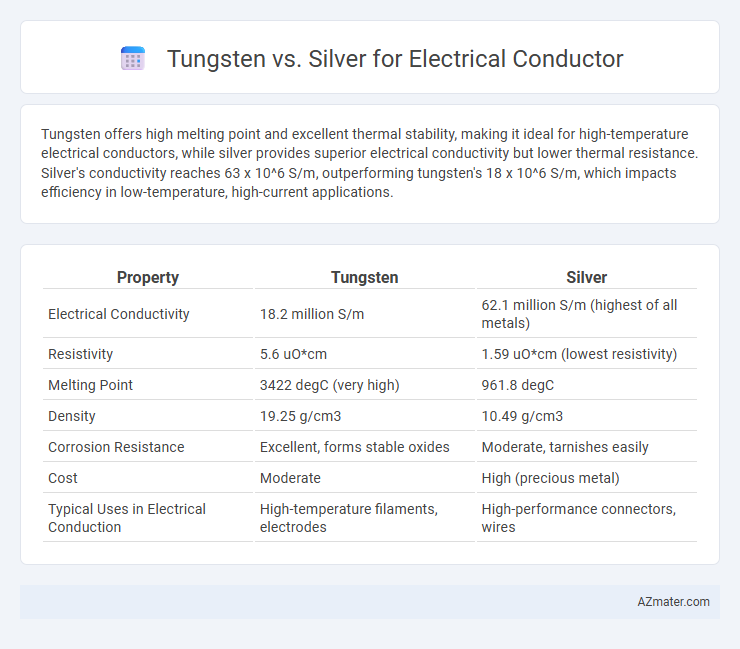Tungsten offers high melting point and excellent thermal stability, making it ideal for high-temperature electrical conductors, while silver provides superior electrical conductivity but lower thermal resistance. Silver's conductivity reaches 63 x 10^6 S/m, outperforming tungsten's 18 x 10^6 S/m, which impacts efficiency in low-temperature, high-current applications.
Table of Comparison
| Property | Tungsten | Silver |
|---|---|---|
| Electrical Conductivity | 18.2 million S/m | 62.1 million S/m (highest of all metals) |
| Resistivity | 5.6 uO*cm | 1.59 uO*cm (lowest resistivity) |
| Melting Point | 3422 degC (very high) | 961.8 degC |
| Density | 19.25 g/cm3 | 10.49 g/cm3 |
| Corrosion Resistance | Excellent, forms stable oxides | Moderate, tarnishes easily |
| Cost | Moderate | High (precious metal) |
| Typical Uses in Electrical Conduction | High-temperature filaments, electrodes | High-performance connectors, wires |
Introduction to Electrical Conductors
Electrical conductors are materials that allow the flow of electric current with minimal resistance, making metals like tungsten and silver critical in various applications. Silver boasts the highest electrical conductivity of all elements, around 63 x 10^6 S/m, making it the most efficient conductor, while tungsten offers significantly lower conductivity, approximately 18 x 10^6 S/m, but excels in high-temperature stability and mechanical strength. The choice between tungsten and silver depends largely on the specific electrical and thermal requirements, with silver favored for low-resistance pathways and tungsten preferred in demanding environments requiring durability and heat resistance.
Overview of Tungsten and Silver Properties
Tungsten features a high melting point of 3422degC and exceptional mechanical strength, making it ideal for high-temperature applications despite its lower electrical conductivity (~31.6% IACS). Silver boasts the highest electrical conductivity among metals (~105% IACS) and excellent thermal conductivity, but it has a low melting point of 962degC and softer mechanical properties. These contrasting properties make tungsten suitable for durable, high-temperature environments, while silver excels in efficient electrical conduction under standard conditions.
Electrical Conductivity Comparison: Tungsten vs Silver
Silver exhibits the highest electrical conductivity of all metals, measuring approximately 63 x 10^6 S/m, making it the most efficient electrical conductor available. Tungsten, with a conductivity around 18 x 10^6 S/m, is significantly less conductive but offers superior mechanical strength and higher melting points. This conductivity difference positions silver as ideal for low-resistance electrical applications, while tungsten suits environments requiring durability and thermal stability.
Thermal Conductivity Differences
Tungsten exhibits significantly lower thermal conductivity than silver, with tungsten around 173 W/m*K compared to silver's exceptional 429 W/m*K. This difference impacts heat dissipation efficiency in electrical conductors, where silver enables quicker thermal management and reduces overheating risks. Despite silver's superior thermal conductivity, tungsten's higher melting point and mechanical strength make it favorable in high-temperature applications.
Corrosion Resistance and Longevity
Tungsten exhibits superior corrosion resistance compared to silver, which tends to tarnish and oxidize over time, reducing its conductivity and aesthetic appeal. The inert nature of tungsten ensures greater longevity in harsh environments, maintaining stable electrical performance without significant degradation. Silver's higher conductivity is advantageous, but tungsten's durability and resistance to corrosion make it preferable for long-term, reliable electrical conduction.
Cost Analysis: Tungsten Versus Silver
Tungsten offers a significantly lower cost per kilogram compared to silver, making it an economically attractive choice for electrical conductors especially in large-scale industrial applications. Silver, despite its superior electrical conductivity and corrosion resistance, commands a much higher market price, which can increase overall project expenses. When balancing performance and budget, tungsten provides a cost-effective alternative for applications where conductivity requirements are moderate but durability and thermal stability are critical.
Mechanical Strength and Durability
Tungsten offers superior mechanical strength and durability compared to silver, making it highly resistant to wear, deformation, and high-temperature environments. While silver has better electrical conductivity, its softness limits its use in applications requiring robust mechanical performance and long-term reliability. Tungsten's high tensile strength and excellent thermal stability ensure prolonged lifespan in demanding electrical conductor roles.
Common Applications in Industry
Tungsten is commonly used in high-temperature environments and electrical contacts due to its exceptional melting point and durability, making it ideal for applications in aerospace and electronics manufacturing. Silver's superior electrical conductivity and corrosion resistance make it the preferred choice for high-performance electrical connectors, conductors in telecommunications, and precision instruments. Both metals play critical roles in industry, with tungsten favored for harsh, high-heat conditions and silver dominating in applications requiring optimal conductive efficiency.
Environmental and Safety Considerations
Tungsten offers superior resistance to corrosion and high temperatures, reducing environmental contamination risks compared to silver, which can tarnish and degrade over time. Silver, while an excellent conductor with low electrical resistance, involves environmentally harmful mining processes and is prone to oxidation that can affect conductivity and safety. Tungsten's higher melting point and durability enhance safety in high-stress electrical applications, minimizing the risk of conductor failure and improving long-term sustainability.
Choosing the Right Material for Electrical Conductors
Tungsten and silver differ significantly in electrical conductivity and application suitability, with silver offering the highest conductivity among all metals, making it ideal for low-resistance, high-efficiency electrical conductors. Tungsten, while having lower electrical conductivity, excels in high-temperature and high-strength applications due to its exceptional thermal and mechanical properties. Selecting the right electrical conductor depends on prioritizing conductivity for performance or durability and temperature resistance for reliability in extreme conditions.

Infographic: Tungsten vs Silver for Electrical Conductor
 azmater.com
azmater.com